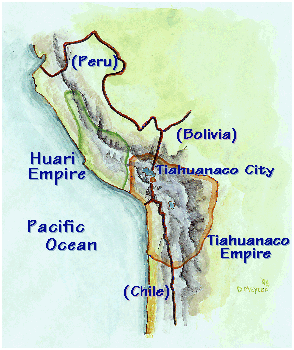
Tiahuanaco - also Tiwanaku - is in the Bolivian Andes lying 12,500 feet (over 2 miles) above sea-level. It is located some 15 miles from the shores of Lake Titicaca. Some have hypothesized that its modern name is a corruption of the Aymara term "taypikala", meaning "stone in the center".
As with many other sacred sites on the planet it remains an enigma allowing reseachers to speculate on its origins and purpose - then paralleling their conclusions with other ancient civilizations - on other major grids points of the planet - left behind by unknown beings - surviving in time - with great stone markers which bear clues to humanity's creational story. Gods, temples, idols, metaphors - all clues in a puzzle humanity is unraveling at this time of conscious awakening. Much of the construction is unfinished.
Tiahuanaco is believed to be the capital of the Pre-Inca Civilization. The city is believed by some to have been built by the Aymara - the Native South Americans inhabiting the Lake Titicaca basin in Peru and Bolivia.
Some believe this is the oldest city in the world. Others believe it was built by an extraterrestrial race who also created the Nazca Lines.
Building was begun at some time before A.D. 500, and there is evidence of additional construction (c.11001300). About 1000, Tiahuanaco culture spread to E Bolivia, N Chile, and Peru; the culture flourished for about 200 years. Built of massive blocks weighing up to 100 tons and brought from several miles away, the structures of Tiahuanaco are superb examples of masonry. The stones, fitted together without mortar, were cut, squared, dressed, and notched with a precision equaled in no other aboriginal South American civilization, not even the Inca. Construction is largely of the platform or monolithic type decorated by conventional incised carving or heads in low relief. The creators of Tiahuanaco also excelled at ceramics; Tiahuanaco painted pottery is one of the great achievements of pre-Columbian art.
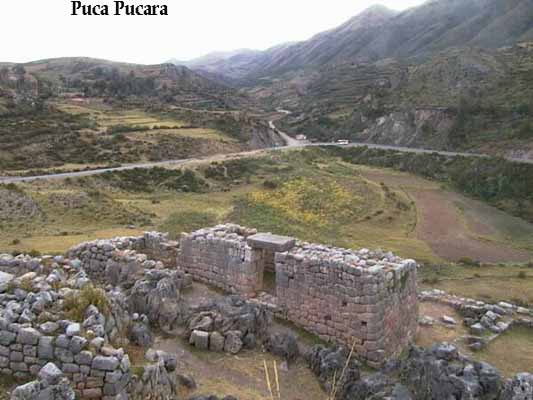
Tiahuanaco was the center of a powerful, self-sustaining empire. The roots of the Tiahuanaco capital can be found in the early village underlying the 1.5-square-mile civic-ceremonial core. The city was settled by 400 B. C. on the Tiahuanaco River, which empties into Lake Titicaca 9.3 miles to the north. The small farming village evolved into a regal city of multi-terraced platform pyramids, courts and urban areas, covering a total 2.31 square miles
Traditionally it is thought to have been built by the predecessors of the Inca Civilization over 2,000 years ago. It is a mysterious ruined city of extremely ancient origins. Some of the massive structures at this site, like the Great Pyramid and the Sphinx in Egypt and Baalbek in Lebanon, date from pre-flood times, as long ago as 10,500 BC.
Around the turn of the 20th century Bolivian scholar Arthur Broznansky began a fifty year study of the ruins of Tiahuanaco. Using astronomical information, he concluded that the city was constructed more than 17,000 years ago long before any civilization was supposed to have existed. He considered Tiahuanaco to be the 'Cradle of Civilization'.
While restoring the city, huge staples were found between the stones. A groove was carve in the edge and molton liquids were poured within, which hardened, forming this staple.
Tiahuanaco society was self-sustaining, for its agricultural, herding, and fishing resource base was more than sufficient to support the complex state administrative apparatus and the population under its control. The Tiahuanaco Empire collapsed between 1000 and 1100 A. D. It was a magnificent royal city that was calculated to inspire awe in the commoners. The walls of the temples and the stone monolithic statues and gateways are now shorn of their gold, textiles, and painted surfaces, which for centuries had shimmered from afar in the bright sunlight.
Little is known of the 30,000 to 60,000 urban dwellers or of the city's crafts or administrative functions. We also know little about the storage system that was required for the bounty of surplus foods from the agricultural fields, the vast llama herds on the Poona, and the abundant fish caught in the lake. The core of this imperial capital was surrounded by a moat that restricted access to the temples and areas frequented by royalty.
Tiahuanaco fell from prominence after Lake Titicaca's water level lowered and the shoreline receded from the city. Today the waters are many miles away.
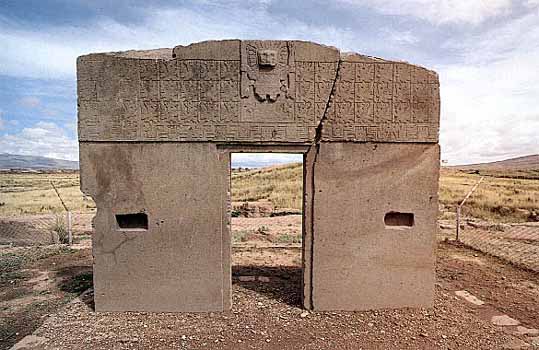
The 10 ton Gateway of the Sun is monolithic, carved from a single block of Andesite granite, and is broken right down the center. Its upper portion is deeply carved with beautiful and intricate designs, including a human figure, condors, toxodons, elephants and some symbols. Directly in the center of the gate is the so-called "Sun-god," Viracocha, with rays shooting from his face in all directions.
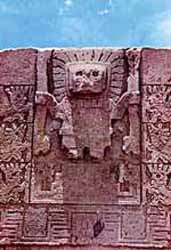
He is holding a stylized staff in each hand which may represent thunder and lightning. He is sometimes referred to as the "weeping god" because tears are on his cheeks. The figures flanking the centerpiece are themselves unfinished, leading investigators to wonder what could have interrupted the craftsmen working on the gate that it was left unfinished. This monolith, when first discovered, was broken in half, and was lying askew deep in silt until restored to its proper position in 1908. The Sun Gate now stands in the northwest corner of the Kalasasaya temple.
Legends of the Aymara Indians say that the Creator God Viracocha rose from Lake Titicaca during the time of darkness to bring forth light. Viracocha was a storm god and a sun god who was represented as wearing the sun for a crown, with thunderbolts in his hands, and tears descending from his eyes as rain. He wandered the earth disguised as a beggar and wept when he saw the plight of the creatures he had created, but knew that he must sustain them.
Viracocha made the earth, the stars, the sky and mankind, but his first creation displeased him, so he destroyed it with a flood and made a new, better one, taking to his wanderings as a beggar, teaching his new creations the rudiments of civilisation, as well as working numerous miracles. Viracocha eventually disappeared across the Pacific Ocean (by walking on the water), setting off near Manta Ecuador, and never returned. It was thought that Viracocha would re-appear in times of trouble. References are also found of a group of men named the suncasapa or bearded ones - they were the mythic soldiers of Viracocha, aka the 'angelic warriors of Viracocha'.
The famous carved figure on the decorated archway in the ancient (pre-Incan) city of Tiahuanaco, known as the "Gateway of the Sun," most likely represents Viracocha, flanked by 48 winged effigies, 32 with human faces and 16 with condor's heads. This huge monument is hewn from a single block of stone, and some believe that the strange symbols might represent a calendar, the oldest in the world. A huge monolithic figure, facing east in the direction of sunrise, stands as silent witness to an unknown civilization established around 2200 years ago.
The entrance side of the Portal of the Sun atop the Kalasaya mound. The entire upper panel is intricately carved with a repeating pattern of the images seen in the view above. The monolith has broken and was found partially downfallen in modern times. It has been restored to its original position. The fissure is visible above the right corner of the doorway.
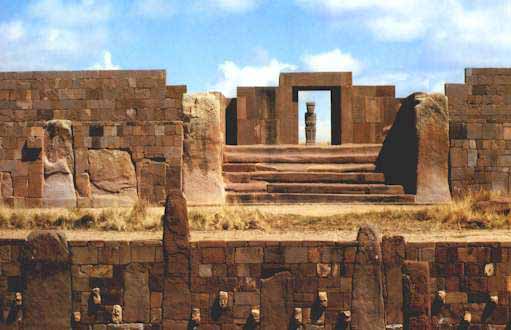
The megalithic entrance to the Kalasaya mound is here seen from the Sunken Courtyard viewing west. The Kalasaya stairway is a well-worn megalith, a single block of carved sandstone. Like the Kalasaya mound, the Sunken Courtyard is walled by standing stones and masonry infill. In this case the stones are smaller and sculptured heads are inset in the walls. Several stelae are placed in the center of the 30 m square courtyard.
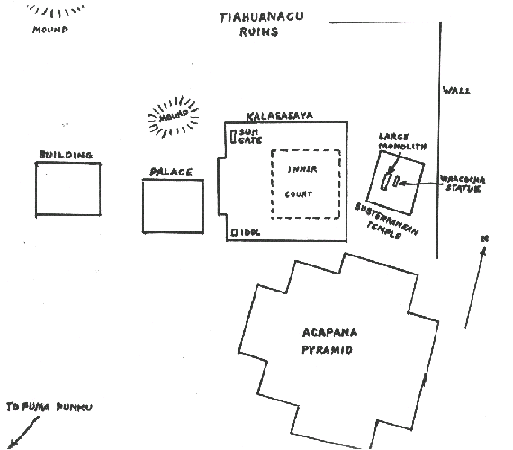
Map of the ceremonial center of Tiahuanacu
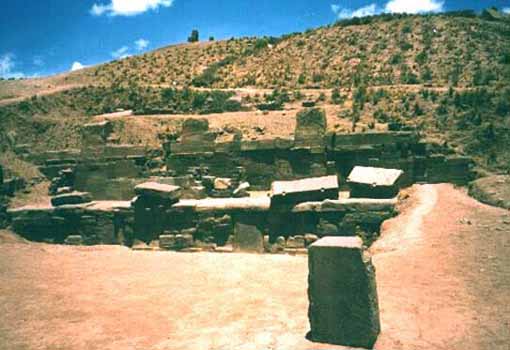
The largest terraced step pyramid of the city, the Akapana, was once believed to be a modified hill, and has proven to be a massive human construction with a base 656 feet square and a height of 55.8 feet. It is aligned perfectly with the cardinal directions. Its base is formed of beautifully cut and joined facing stone blocks. Within the cut- stone retaining walls are six T- shaped terraces with vertical stone pillars, an architectural technique that is also used in most of the other Tiahuanaco monuments. It originally had a covering of smooth Andesite stone, but 90% of that has disappeared due to weathering. The ruinous state of the pyramid is due to its being used as a stone quarry for later buildings at La Paz. Its interior is honeycombed with shafts in a complicated grid pattern, which incorporates a system of weirs used to direct water from a tank on top, going through a series of levels,and finally ending up in a stone canal surrounding the pyramid. On the summit of the Akapana there was a sunken court with an area 164 feet square serviced by a subterranean drainage system that remains unexplained.
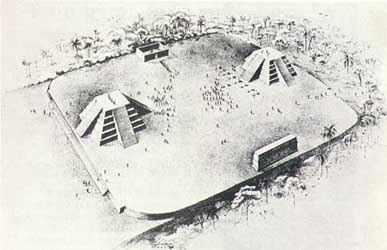
Associated with the Akapana are four temples: the Semi-subterranean, the Kalasasaya, the Putuni, and the Kheri Kala. The first of these, the Semi-subterranean Temple, was studded with sculptured stone heads set into cut-stone facing walls and in the middle of the court was located a now-famous monolithic stela. Named for archaeologist Wendell C. Bennett who conducted the first archaeological research at Tiahuanaco in the 1930's, the Bennett Stela represents a human figure wearing elaborate clothes and a crown. The ancient Tiahuanaco heartland is estimated to have been about 365,000, of whom 115,000 lived in the capital and satellite cities, with the remaining 250,000 engaged in farming, herding, and fishing.
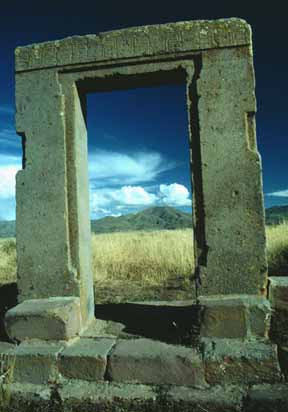
This megatlithic doorway is all that remains of the walls of a building on a small mound near the Kalasaya. Much of the readily accessible masonry at the ruin was used to construct the Catholic church in the village. A nearby railroad bridge also has Tiahuanaco stone.
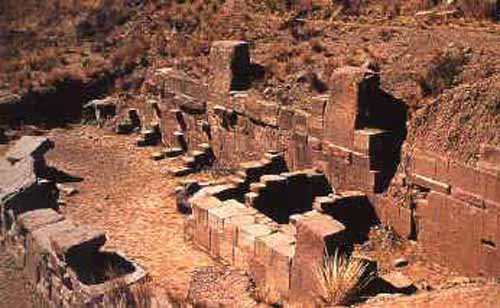
Adjacent to the sunken court, residences of the elite were revealed, while under the patio the remains of a number of seated individuals, believed to have been priests, faced a man with a ceramic vessel that displayed a puma-an animal sacred to the Tiahuanaco. Ritual offerings of llamas and ceramics, as well as high-status goods made of copper, silver and obsidian were also encountered in this elite residential area. The cut-stone building foundations supported walls of adobe brick, which have been eroded away by the yearly torrential rains over the centuries.
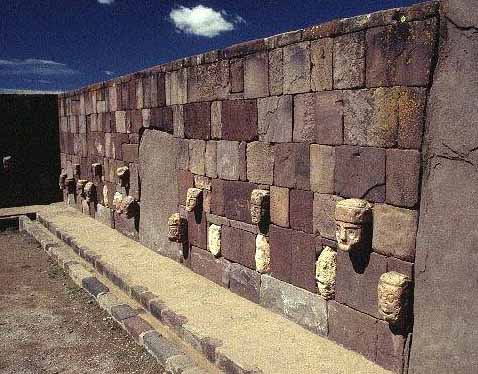
In 1934 the Peruvianist Wendell C. Bennett carried out several excavations at Tiahuanacu. Excavating in the Subterranean Temple he found two large stone images. One was a bearded statue. Depicted are large round eyes, a straight narrow nose and oval mouth. Rays of lightning are carved on the forehead.
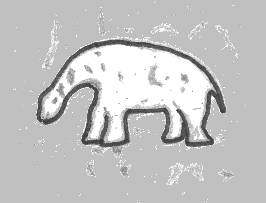
Strange animals are carved up around the head. It stands over 7 feet tall with arms crossed over an ankle- length tunic, which is decorated with pumas around the hem. Serpents ascend the figure on each side, reminding one of the Feathered Serpent culture-hero known as Quetzalcoatl in Central America.
Beside the bearded statue was a much larger statue called in Bennett's report "the large monolithic statue". It is the largest - over 24 feet tall - and probably the most interesting. It was sculpted out of red sandstone, and is generally covered with carved images of various kinds. He holds objects in each hand which are totally unidentifiable, although numerous interpretations have been suggested. It has been removed from the site and now stands in a plaza in La Paz.
What is most interesting is the lower half of its body, which is covered with fish-scales (which upon close inspection are actually fish-heads). Immediately one recalls the Mesopotamian deity called Oannes, the man-fish amphibious being who conveyed special knowledge to ancient mankind.
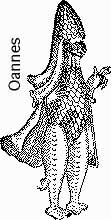
In truth all of these gods - no matter what civilization you are reafing about - were the same person / soul - creating realities based on Sacred Geometry - the same characters playing different roles in different places.
This monolithic piece of work has a number of designs scattered over its surface, many of which resemble the running winged-figures found on the Gate of the Sun, only with curled-up tails. Also the "Weeping god" is depicted on the sides of the head of the statue. This is in addition to the tears already depicted on the cheeks of the monoliths face. The Weeping god seems to be a major theme at Tiahuanacu. One wonders what made their deities so sad. Other designs, although very artistic, are rather hard to describe.
There are numerous other statues which have been found at Tiahuanacu, several of which have found their way into various museums. Most have the incomprehensible stiff designs scattered about on their surfaces in the typical Tiahuanacu style. Some are rather large, and others are small. Depictions of toxodons and several other extinct creatures are plentiful at Tiahuanacu. The images of these extinct animals are understandable on pottery and textiles - they could be copied by anyone from the stone monuments dotting the area.
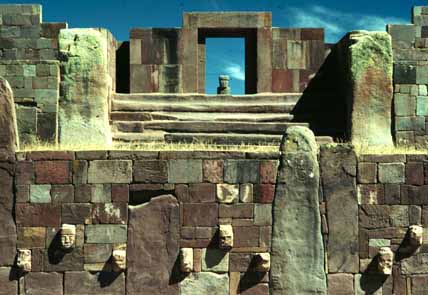
The most important edifice for dating purposes is the Kalasasaya ("Place of the Vertical Stones"). It is built like a stockade with 12 foot high columns jutting upward at intervals, each of these being carved into human figures.
In the northwest corner stands the Gateway of the Sun, and in the southwest corner is "the idol".
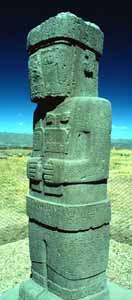
The Idol
This is one of two large anthropomorphic figures standings in the southwest corner of the Kalasasaya Temple. This one faces the entrance and is placed on the central axis. The andesite stone used at the ruins was transported from 100 kilometers distance. The sandstone was quarried about 10 miles from the site. With the exception of the Sun Gate, it is the most picturesque of the sculptures at Tiahuanacu, since its 7-foot height is almost covered with hieroglyphic-like carvings. No one knows if these carvings represent a form of writing or are merely decorative. Should these carvings prove to be aform of symbolic writing, what a story they might tell! The statue popularly known as El Fraile is almost devoid of carvings.
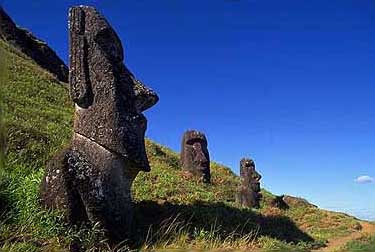
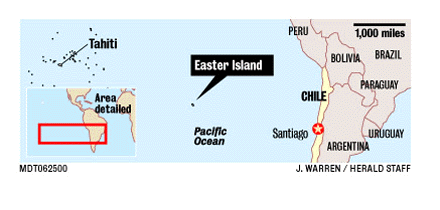
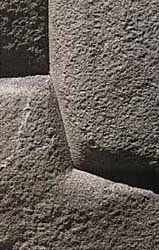
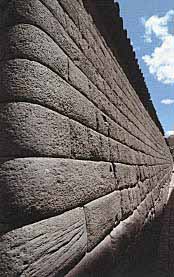
Some researchers have concluded that the ancients constructed the site with astronomical alignments in mind called Celestial Observatories.
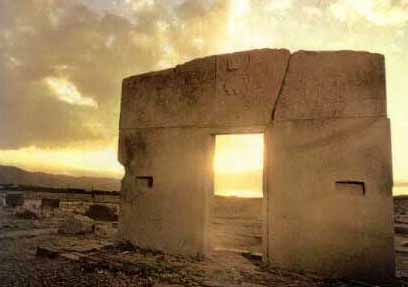
As the sun rises each day it moves along the horizon and it rises in a different spot. To measure this movement they built the temple itself as a giant clock to tell them how the progression of the sun was proceeding. We can use those same astronomical alignments to date the site.
On the first day of spring the sun rose exactly through the center of the archway of the temple. Based on the layout of the temple he deduced that on the first day of winter and the first day of summer the sun should rise over each of the huge cornerstones. But this is not the case. The position of the sun was, for some reason slightly outside the corner markers. The solstice markers are not misaligned.
Polish-born Bolivian archaeologist Arturo Posnansky has concluded that the Tiahuanaco culture began in the region at about 1600 B.C. and flourished until at least 1200 A.D. He studying the thin layer of lime deposits in the stone indicating that they had been underwater for a considerable period of time. Also, certain parts of the ruins were deeply buried in sediments, which indicated that a stupendous wave of water had washed over the entire area. Posnansky suggested the Biblical Flood may have been the reason for these deposits.
Peruvian legends clearly relate a story of world-wide flood in the distant past. Whether it was the biblical flood of Noah, or another one, we cannot say, but there is ample physical evidence of a universal inundation, with the world-wide deluge described in more than a hundred flood-myths. Along with Noah's flood were the Babylonian Utnapischtim of the Gilgamesh epic, the Sumerian Ziusudra, the Persian Jima, the Indian Manu, the Maya Coxcox, the Colombian Bochica, the Algonkin's Nanabozu, the Crows' Coyote, the Greek Deukalion and Pyrrha, the Chinese Noah Kuen, and the Polynesian Tangaloa. It is evident there was a world-wide deluge 19,000 years ago.
(Global doomsdays are conspicuous in the Hopi Indian legends, the Finnish Kalevala epic, the Mayan Chilam Balam and Popol Vuh, and in the Aztec calendar, the last of which predicts that our present civilization will be destroyed by "nahuatl Olin" or "earth movement," that is, devastation by earthquake. Due to Aztec cyclic theory this will become the fifth doomsday after the "death of the Jaguars," "the death of the Tempests," "the death of the Great Fire" (vulcanism), and "the Great Deluge."
If a flourishing advanced civilization existed on the Peruvian altiplano many thousands of years ago and was reached by the flood waters, many problems would be solved, such as the existence of Tiahuanaco's ruins under 6 feet of earth at an elevation of 13,300 feet. The presence of stone structures still under the lake's waters and the existence of marine life at an impossible altitude would also make sense.
In addition, the depiction of extinct Pleistocene animals, the traces of an ancient shoreline, and finally, the paradox of a seaport existing at an altitude of 12,500 feet above sea level, lead Posnansky to look for other indications that these ruins might be extremely old. He discovered alignments with the sun which were slightly "out of true," but which lined up perfectly once the skycharts were moved back in time, and this lead intensive astronomical studies.
Prof. Posnansky summed up his 50 year study in a 4 volume work entitled Tiahuanacu, The Cradle of American Man first published in 1945. He explains his theories, which are rooted in archeoastronomy, as follows. Since Earth is tilted on its axis in respect to the plane of the solar system, the resulting angle is known as the "obliqueness of the ecliptic".
One should not confuse this with another astronomical phenomenon known as Precession of the Equinoxes, as critics of Posnansky have done. If viewed from the Earth, the planets of our solar system travel across the sky in a line called the plane of the ecliptic. At present our Earth is tilted to cause this angle to be around 23 degrees and 27 minutes, but this is not constant. The Earth's axis oscillates slowly between 22 degrees and 1 minute to an extreme of 24 degrees and 5 minutes. This cycle (repeating itself from one extreme to the other and back) takes roughly 41,000 years to complete. The alignments at the Kalasasaya temple depicts a tilt of the Earth's axis amounting to 23 degrees, 8 minutes, 48 seconds, indicating a date of 15,000 B.C.
Between 1927 and 1930 Prof. Posnansky's conclusions were studied intensively by a number of authorities. Dr. Hans Ludendorff (Director of the Astronomical Observatory of Potsdam), Friedrich Becker of the Specula Vaticana, Prof. Arnold Kohlschutter (astronomer at Bonn University), and Rolf Muller (astronomer of the Institute of Astrophysics at Potsdam) verified the accuracy of Posnansky's calculations and vouched for the reliability of his conclusions.
There is one solution that can satisfy all of the above mysteries regarding the ruins of Tiahuanacu. This is none other than the geological cataclysm that inaugurated the Pleistocene Extinction, which effected the entire globe geologically and climatically. Thus, if Tiahuanacu was built before the Pleistocene Extinction, which occurred at the end of the last ice age around 12,000 years ago, then the astronomical alignments built into the Kalasasaya harmonize with the apparent age of the city, and Prof. Posnansky's conclusions seem to be correct. Tiahuanacu was most likely built close to the date of 15,000 B.C.




0 comments:
Post a Comment